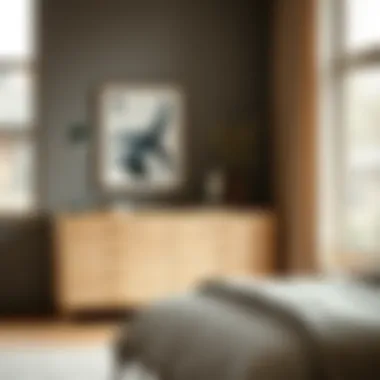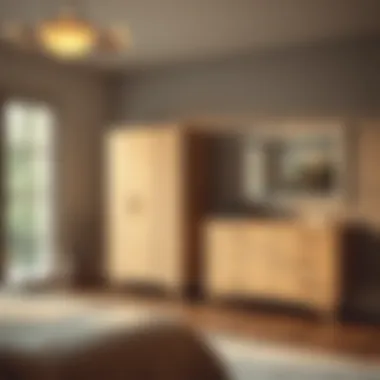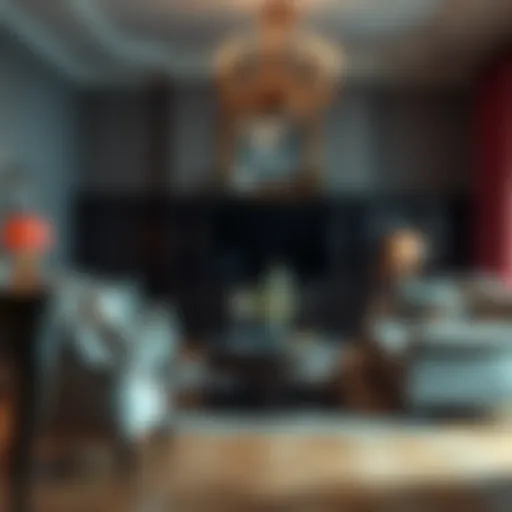Light Tone Dressers: A Fusion of Style and Usefulness


Intro
The modern living space often reflects a delicate balance between style and functionality. One element that resonates with both aspects is the light tone dresser. These pieces of furniture not only serve as practical storage solutions but also infuse elegance and brightness into a room. As interior design evolves, understanding the characteristics and benefits of light tone dressers becomes essential for homeowners, designers, and decor enthusiasts alike. This article delves deep into the distinction and appeal of these versatile dressers, guiding you through their styles, care, and maintenance, ensuring you make informed choices to enhance your home.
Furniture Styles and Trends
In today's home design world, light tone dressers fit seamlessly into a variety of styles, making them a popular choice. They are often associated with a clean, airy feel that modern interiors crave while possessing the warmth that traditional decor offers.
Modern vs. Traditional: Understanding the Aesthetics
Light tone dressers can be found in both modern and traditional forms, each offering distinct aesthetic qualities. In modern designs, think sleek lines, minimalistic hardware, and often a lacquered finish that reflects light. These dressers sometimes feature geometric patterns or asymmetrical designs, striking a contemporary chord in any room.
Conversely, traditional dressers lean towards ornate details—think carved legs, richer textures, and classic hardware accents. These pieces evoke a sense of timelessness, integrating flawlessly in rustic or vintage-themed settings. The light tones work here to brighten up dark wood or complex prints, providing a much-needed contrast. The choice between these styles often comes down to individual preference, but understanding these differences can assist in making a thoughtful purchase.
Color and Material Trends: What's In and What's Out
When it comes to color, light tones are catching the eye; soft whites, pale grays, and muted beige are among the current favorites. These hues create an illusion of space and purity within the room and tend to blend effortlessly with various color palettes.
In terms of materials, wood remains the reigning champion. However, light tone dressers are increasingly crafted from sustainable options like bamboo or engineered wood. These materials not only cater to eco-conscious consumers but also offer durability and longevity.
A few materials and finishes to keep an eye on includes:
- Scandinavian wood - Known for its light and airy feel
- Painted finishes - For those who want a pop of color while keeping it subtle
- Textured surfaces - Adding a touch of uniqueness and depth
Light tone dressers are not just about storage; they are about creating a visual experience that enhances your home’s narrative.
Furniture Care and Maintenance
Caring for your furniture ensures that it withstands the test of time. Light tone dressers, while elegant, do require some attention to retain their youthful charm.
Tips for Prolonging the Life of Your Furniture
- Dust Regularly: Use a soft cloth to avoid scratching the surface. Dusting might seem trivial, but it helps keep the wood looking fresh and clean.
- Avoid Harsh Chemicals: When cleaning, opt for mild soap or specialized wood cleaners. The wrong cleaner can leave marks or damage the finish.
- Direct Sunlight: Try to keep your dresser away from direct sunlight. Over time, exposure can fade the color and alter the sheen.
DIY Repair Hacks for Common Furniture Issues
- Minor Scratches: For light scratches, a simple walnut rub can work wonders. Just take the meat of the walnut and gently rub over the scratch.
- Water Rings: Mix equal parts of olive oil and vinegar. Gently rub this mixture on the affected area with a soft cloth.
By adhering to these care tips, your light tone dresser can keep shining in all its glory, enhancing the beauty and functionality of your living space.
For more information on furniture care, consider checking resources like This Old House. Explore the toolkit of maintenance and creativity to better enjoy and preserve your cherished pieces.
Prelude to Light Tone Dressers
Light tone dressers have emerged not just as mere furniture pieces, but as vital components that transform spaces. They carry an understated elegance that resonates with various interior design aesthetics. Their shades, usually lying between white and soft beige, radiate warmth and freshness, making them a popular choice among homeowners, retailers, and designers alike.
Understanding Light Tones
In the world of design, light tones tend to evoke feelings of calmness. They can create an open and airy atmosphere, an essential factor for smaller rooms or spaces that lack natural light. For instance, a light-hued dresser can serve as a focal point while also subtly blending into the surroundings. When you pair it with darker accents—such as a black mirror or a deep navy wall—you create a visual contrast that keeps the setting from feeling washed out. This balance is not just pleasing to the eye but also resonates deeply with the human psyche, promoting well-being and comfort.
The Significance in Modern Interiors
Today’s modern interiors are all about adaptability and simplicity, and that’s where the light tone dresser shines. These pieces easily complement a variety of styles, from minimalist charm to rustic coziness. A light tone dresser can seamlessly fit whether placed in a coastal-themed bedroom or a contemporary living room, offering a versatile charm.
By incorporating light tone dressers, you’re not just furnishing a space; you’re building a narrative of style and functionality that engages anyone who enters.
Furthermore, as sustainability takes the front seat in many consumers’ minds, manufacturers are increasingly opting for eco-friendly materials. Many light tone dressers are crafted from sustainable wood sources or engineered materials, giving these pieces an additional layer of appeal. Not to forget, they often feature practical designs that focus on maximizing storage while ensuring that the dresser remains an aesthetic pleasure.
In summary, light tone dressers are significant in modern interiors due to their versatility, ability to enhance light, and simplified elegance. They align with both aesthetic and functional demands of today’s savvy homeowners, making them a must-have in any thoughtfully designed space.
Key Design Features of Light Tone Dressers
When it comes to light tone dressers, design features play a crucial role in determining their functionality and appeal in a home. From the materials they are made from to the styles they embody, every detail counts. The choice of design elements can enhance the aesthetics of a room while ensuring that the furniture serves its purpose effectively. Understanding these features enables homeowners and designers alike to make well-informed decisions, tailoring the pieces to suit personal tastes and living spaces.
Materials Used
The materials chosen for light tone dressers significantly influence their durability and overall vibe in a room. Let’s take a closer look at three main materials commonly used in these pieces:
Solid Wood
Solid wood remains a favored option for dressers, valued for its sturdiness and longevity. This kind of material brings an air of timelessness to any setting, making it a solid choice for those looking to invest in lasting furniture. Characteristically, solid wood pieces often feature unique grain patterns that add depth to the aesthetic.
One unique feature of solid wood is its ability to age gracefully, developing a patina that enhances its beauty over time. While it can be on the pricier side compared to other materials, the investment is well worth it for its durability. However, it's important to bear in mind potential downsides; solid wood can be prone to warping if exposed to sudden changes in humidity, so a stable environment is ideal.


Engineered Wood
Engineered wood has gained momentum as a more affordable alternative without sacrificing too much in terms of quality or appearance. This material consists of several layers of wood fibers glued together, creating a sturdy yet lightweight structure. Its primary advantage lies in the consistency of its quality, avoiding the flaws sometimes seen in solid wood entities.
What stands out about engineered wood is that it can be manufactured with various finishes, easily mimicking the look of natural wood while being more cost-effective. On the flip side, it may not offer the same long-term value as solid wood, and can be less resistant to water damage, especially if not properly sealed.
Metal Accents
Incorporating metal accents into the design of light tone dressers introduces a modern twist, creating striking contrasts with wood or engineered materials. Metal knobs or legs are not only stylistic choices but also add a sense of openness, allowing light to flow around the piece.
Key to metal accents is their durability—they endure wear and tear admirably and require minimal maintenance. This quality makes them a popular addition in contemporary decor. However, a consideration here is that certain metal finishes may tarnish over time, posing a slight challenge to upkeep.
Styles and Aesthetics
Styles and aesthetics of light tone dressers can set the tone of an entire room, appealing to a variety of tastes. Exploring popular styles helps pinpoint what aligns with one’s vision for interior design.
Minimalist
Minimalist design focuses on simplicity and clean lines, championing the mantra of “less is more.” A minimalist light tone dresser seamlessly integrates into the decor without overwhelming the space. Its key characteristic is usually the absence of ornate details, emphasizing functionality over embellishment.
Some unique features include sleek shapes and the use of space efficiently. Minimalist dressers can create a feeling of airiness and ease, which is especially beneficial in smaller rooms. However, for those who prefer a more personalized touch, this type of design may lack character.
Scandinavian
Scandinavian style emphasizes harmony with nature, often characterized by light colors and natural materials. This aesthetic focuses on functionality, making it a well-suited choice for light tone dressers. The key characteristic is a blend of comfort and purpose, design that embraces simplicity yet is visually intriguing.
Unique features of Scandinavian design include tapered legs and subtle curves, adding warmth to the room. A potential downside is that some might find these dressers too plain if they seek more intricate designs.
Coastal
Coastal style often invokes feelings of relaxation and freshness, making it ideal for beach homes or those who appreciate a seaside vibe. The key characteristics typically involve light, breezy tones and natural textures. Light tone dressers in this style can carry elemental charm with hues reminiscent of sand and surf.
What’s unique about this aesthetic is how it incorporates weathered finishes, which can evoke a sense of laid-back luxury. However, the challenge often lies in achieving the right balance; too many decorative elements can tip the scale towards clutter instead of the desired tranquil ambiance.
The design features not only shape the physical appearance of light tone dressers but can also dictate how well they serve their intended purpose in a home.
By considering the materials and styles discussed, one can appreciate the nuanced ways in which light tone dressers can enhance living spaces while meeting functional needs. The thoughtful selections can lead to pieces that not only complement the interior but also become integral to everyday life.
Functional Benefits of Light Tone Dressers
Light tone dressers serve more than just aesthetic purposes; they bring a range of functional advantages that can transform the feel and functionality of a space. When homeowners or designers look for furniture, the light tone dresser often stands out not just for its beauty but also for how it can enhance living areas. Here’s a look at the key functional benefits these pieces offer and how they can be a game-changer in modern interiors.
Space Enhancement
One of the hallmark features of light tone dressers lies in their ability to enhance space. In many homes, especially those with smaller or differently shaped rooms, creating an illusion of expansiveness is crucial.
Creating an Illusion of Space
Light colors, as a rule, tend to reflect light rather than absorb it, making rooms feel more open. When you place a light tone dresser against a wall, it visually recedes into the background. This creates an effect where the walls feel further away, which can be particularly beneficial in compact areas. It’s not just about color; it’s also how a light tone dresser can complement other design elements.
For example, a soft beige dresser in a room painted in pastels helps create a seamless transition between walls and furniture.
"Light tone furniture can trick the eye, making a cramped room breathe – it’s all about perspective."
This characteristic is especially appealing for those wanting to maximize the usability of their space. However, while a lighter palette can make rooms appear larger, it’s worth noting that they may require more maintenance to keep them looking pristine, as dirt and marks can stand out more than on darker surfaces.
Maximizing Natural Light
Natural light not only adds warmth to any room but also lifts spirits. Well-placed light tone dressers can organize a space in a way that encourages natural light to bounce around the room. The reflections off a light surface can increase brightness, making living areas feel uplifting and inviting.
When selecting a dresser, think about placement. A dresser near a window can act as a light amplifier, allowing natural illumination to pour in. This feature makes light tone dressers particularly suitable for sunny locales and urban apartments where space is often shared with large windows.
Yet, while the interplay of light and dressers is visually attractive, homeowners must also keep in mind that too much sun exposure can cause colors to fade over time, so care should be given to manage sun exposure appropriately.
Versatile Storage Solutions
On top of their aesthetic contributions, light tone dressers are functional enhancers when it comes to storage. Their design often emphasizes organization and accessibility while maintaining a stylish appearance.
Stylish Organization
In terms of storage solutions, light tone dressers can be cleverly designed to offer organization without sacrificing style. Many models incorporate drawers of various sizes, providing a place for everything from clothes to accessories, while still presenting a unified and clean look.
Stylish organization is key to functionality in a busy household. A well-designed dresser can simplify daily routines, helping family members easily find what they need.


Furthermore, with the embrace of trends like open shelving and transparent organizers, light tone dressers can present more than a storage option; they can serve as a statement piece that showcases personal style while keeping items tidy. However, this stylish approach comes with the caveat that items on display need regular care to ensure they maintain their visual harmony.
Multi-Functional Use
Light tone dressers don’t just sit idle — they often serve multiple purposes within a home. Beyond storage, many people creatively repurpose dressers as workspace, entryway tables, or even changing stations for infants. This adaptability makes them a wise investment for modern homes where flexibility is often a necessity.
For example, a dresser can be placed in a hallway and used for dropping keys or mail while also providing essential storage. This dual functionality highlights the practicality that light tone dressers bring, making them a preferred choice for minimalistic lifestyles. But it is essential to consider the overall space; if a dresser is overstuffed, it can lose its intended multifunctional appeal, becoming a cluttered inconvenience rather than a clever solution.
Choosing the Right Light Tone Dresser
Selecting the ideal light tone dresser can feel a bit like finding a needle in a haystack, considering the myriad of styles and functionalities out there. Yet, honing in on the right dresser is crucial, as it not only elevates the aesthetic appeal of a space but also aligns with your personal style and practical needs. This section will guide you through the essential elements to consider when choosing the perfect light tone dresser for your home.
Assessing Personal Style
Your personal style sets the tone for your living spaces. When selecting a light tone dresser, it is essential to take a moment and reflect on what resonates with you. Are you drawn to minimalist designs that boast clean lines, or do you prefer something that evokes a more rustic charm? Often, individuals may overlook how personal preferences can impact their overall home decor.
One way to pinpoint your style is by considering your existing furniture and decor. If your living space leans towards contemporary styles, a sleek dresser in a soft ash finish can do wonders. Alternatively, if your home feels more eclectic, a dresser with vintage charm and weathered light wood might blend in beautifully.
Incorporate elements that speak to you by looking at color palettes, textures, and even cultural influences that inspire your home. Ultimately, your dresser should reflect who you are, acting as a functional yet decorative asset in your space.
Size and Space Considerations
Measuring Your Space
Accurate measurements are non-negotiable when choosing a light tone dresser. If you're thinking of a beautiful addition, understanding the dimensions of the area it will inhabit lays the groundwork for good decisions. This act isn't just about fitting the dresser into a nook; it's about how the piece interacts with the surrounding area.
The key characteristic of measuring your space is its potential to prevent costly mistakes. Imagine lovingly selecting a dresser only to realize it can't squeeze through your door. This meticulous planning ensures that the piece enhances, rather than hinders, your flow—making your environment feel cohesive.
A unique feature of taking measurements is that it allows you to visualize placement options. You might find that an angled placement helps to create more depth in a room or that a straightforward position maximizes functionality. Remember, a well-measured space is a happy space!
Proportions and Balance
The concept of proportions and balance is fundamental when integrating a light tone dresser into your decor. This consideration involves not only the size of the dresser but its relation to other furniture pieces and overall room layout. A heavy, large dresser can dominate a small bedroom, while a petite one might get lost in a vaster living area. Finding that sweet spot is pivotal for maintaining harmony throughout the space.
In terms of balance, one should think practically when visualizing your arrangement. The dresser should fit naturally within the context of the room's size and layout. The right proportions can create an enhanced aesthetic, making even a modest dresser appear grand without overwhelming its surroundings.
One advantage of focusing on this aspect is that it opens up opportunities to mix and match styles, colors, and materials—offering versatility in your decor approach. Striking this balance ensures the light tone dresser enhances your interior design story rather than becoming an afterthought.
Ultimately, choosing the right light tone dresser is about merging beauty with practicality. Balance your preferences and functional needs, and you'll find a piece that truly nestles into the heart of your home. By understanding your personal style, and measuring your room with proportions in mind, your search can yield a stunning centerpiece that complements your living environment.
Caring for Your Light Tone Dresser
Caring for your light tone dresser is not just about keeping it looking good. It taps into preserving its charm and functionality for years to come. This section will highlight essential cleaning and maintenance practices that homeowners and decor enthusiasts can easily implement. Regular care not only extends the life of your dresser but also ensures that it retains its original luster and appeal in your space.
Routine Cleaning Practices
Keeping your light tone dresser pristine requires routine cleaning, which is a straightforward yet often overlooked practice. Dust accumulation can dull surfaces over time, making it appear neglected. A simple microfiber cloth can work wonders, capturing dust without scratching the wood. For those stubborn smudges and spots that crop up, a mixture of warm water and mild soap should be your go-to. Just dampen the cloth—don’t soak it—and wipe the surface down gently, following up with a dry cloth to avoid residue.
Additionally, consider polishing your dresser with a quality wood polish every few months. This not only adds shine but forms a protective layer against minor scratches and stains. When done regularly, cleaning becomes almost second nature, allowing your light tone dresser to remain a stunning focal point in your home.
Preventative Maintenance Tips
Avoiding Sun Damage
Sun damage is a sneaky foe for your prized dresser. Prolonged exposure to direct sunlight can lead to fading and warping, which might not be immediately visible. The harmful UV rays can cause the finish to deteriorate, making your beautiful dresser look lackluster over time.
One practical approach is to position your dresser away from direct sunlight, if possible. If that’s not an option, consider using sheer curtains to diffuse those harsh rays or UV-blocking window films for a more permanent solution. Not only does minimizing sun exposure keep the dresser’s color intact, but it also safeguards its structural integrity, ensuring it stands the test of time.
Proper Humidity Levels
Humidity levels in your home play a crucial role in the wellbeing of your light tone dresser. Wood is a natural material, and it interacts with moisture in the air. Too high humidity can cause the wood to swell, potentially leading to warping or joint separation. Conversely, excessively dry conditions can lead to cracking and splitting.
Ideally, the relative humidity in your home should hover around 40-50%. This is often easily achievable with a good home humidifier during dry months or a dehumidifier in humid seasons. Keeping your dresser in a climate-controlled environment not only preserves its beauty but also maintains its structural integrity, making it a smart choice for those serious about their furniture care.
"Treat your light tone dresser with care, and it will reward you with years of beauty and practicality."
In summary, taking the time to maintain and care for your light tone dresser ensures that it continues to appeal and function beautifully. Whether through cleaning or carefully controlling your environment, these simple practices can significantly impact your dresser's life and appearance.
Incorporating Light Tone Dressers in Various Spaces
In modern homes, the role of furniture goes beyond functionality; it plays a pivotal part in the overall atmosphere and aesthetic appeal. Light tone dressers, with their innate charm and versatility, fit seamlessly into a variety of spaces. When we think about incorporating these pieces, it is essential to understand how they mesh with the surrounding décor while enhancing both utility and style. Here are some critical aspects to consider:
- Adaptability: Light tone dressers can serve multiple purposes, whether as a striking focal point or a subtle storage solution, making them ideal for various rooms.
- Harmonizing Elements: By choosing the right dresser, you can create a cohesive look across your living spaces, coordinating colors, shapes, and materials.
- Personal Touch: They provide ample opportunities for personalization, allowing homeowners to express their unique style through accessories and placements.


Bedroom Integration
Designing with Dressers
The placement and design of dressers in bedrooms are crucial as they can thus play a part in style and practicality. A well-placed light tone dresser not only complements the bed but can amplify the entire room's vibe. One key characteristic is how they can create a calming environment. For instance, a light oak dresser can lend a serene vibe in a room decorated with soft pastels or floral patterns.
- Functionality: Allowing for organization while adding to the visual appeal.
- Space Optimization: Dressers can often double as seating surfaces or display areas for decor.
- Variety in Design: Options range from modern minimalist looks to intricate vintage styles, providing numerous possibilities based on individual preferences.
The unique feature of designing with dressers lies in their structural presence. A large light tone dresser can offer a symmetrical balance, enhancing the space without seeming cumbersome. However, the disadvantage may include the need for adequate floor space, as oversized dressers might overwhelm smaller rooms.
Color Compatibility
Color compatibility is a vital aspect when integrating light tone dressers into bedrooms. Selecting the right tones can either make decorations pop or create a seamless blend with other furniture. A light beige dresser, for example, can work wonders with a variety of color palettes—be it warm earth tones or cool greys.
- Visual Harmony: It is not just about color but also about how light interacts within the space.
- Enhancing Natural Light: Light colors tend to reflect more sunlight, which can make a bedroom feel airy and expansive.
The unique feature of color compatibility is its ability to set the mood. Lighter hues can evoke feelings of tranquility and relaxation, necessary for a restful night. But on the other hand, a potential disadvantage is that light-tone furniture may show stains or wear more prominently than darker pieces, requiring more careful maintenance.
Living Room Use
Style Cohesion
In the living room, style cohesion plays an enormous role in creating a harmonious environment. A light tone dresser can bridge different design elements within the space. For instance, combining a light pine dresser with darker furnishings can create a striking visual contrast that elevates the room’s overall aesthetic while ensuring it all feels balanced.
- Creating Flow: The consistency of style ensures that all elements look intentional rather than mismatched.
- Adaptable Designs: Light tone dressers often fit well within various styles, be it contemporary, rustic, or eclectic.
The distinctive aspect of style cohesion is its contribution to a story that your home tells. A well-coordinated room feels more inviting and thoughtfully designed. An added disadvantage could be the challenge of integrating diverse styles without looking cluttered, as mixing too many styles may lead to confusion in overall aesthetics.
Accessorizing Around the Dresser
Accessorizing around the dresser brings in an opportunity to reflect personal style. This includes adding decorative elements like lamps, plants, or picture frames, enhancing the dresser's role as a storage solution while making it a focal point.
- Personal Expression: Adding decorative items allows families to showcase their history and tastes, which adds warmth to the space.
- Functionality: Accessories can also serve practical purposes—think of trays for keys or decorative boxes for mail.
The unique feature of accessorizing lies in its transformational power. A simple light dresser can evolve into a curated display with the right adornments. However, it is important to keep in mind that over-accessorizing can lead to clutter, making the dresser's functionality secondary to the aesthetic considerations.
"The right light tone dresser, when placed strategically and accented thoughtfully, can be the spotlight of any room—adapting to its surroundings while standing out just enough."
Trends and Innovations in Light Tone Dressers
The realm of light tone dressers is continuously evolving, mirroring a blend of contemporary design preferences and the changing needs of today’s homeowners. Understanding these trends isn't just for the sake of staying current; it provides insights into how to better incorporate these pieces into diverse spaces. Homeowners and designers alike should note the growing emphasis on sustainable materials and multifunctionality, characteristics that enhance both aesthetics and practicality.
Eco-Friendly Options
In a time of increasing environmental awareness, the rise of eco-friendly light tone dressers has become both a trend and a necessity. Many manufacturers are prioritizing sustainable sources for their materials, favoring woods that are reclaimed or sourced from well-managed forests. This not only appeals to a conscientious customer base but also contributes to overall interior air quality, as certain finishes and adhesives can emit harmful substances over time.
Moreover, selecting eco-friendly options often means a commitment to durability. Dressers made from sustainably sourced materials tend to have a longer lifespan, which in turn reduces overall consumption. They can blend seamlessly into various design schemes, all while fulfilling a recyclable or biodegradable ethos. Notable brands are now incorporating certifications, such as Forest Stewardship Council (FSC), into their marketing, providing transparency for interested buyers.
Smart Furniture Solutions
Integrated Technology
With the proliferation of smart home technology, light tone dressers are not remaining behind. The integration of technology into furniture has become a notable characteristic of modern designs, with many dressers now featuring built-in USB ports or wireless charging stations. This innovation meets the demand for convenience, allowing individuals to declutter surfaces while keeping their devices charged and ready to go.
The key benefit of integrated technology is its ability to enhance user experience without compromising aesthetics. Manufacturers are creating sleek designs that mask these technological features, keeping appearances minimalist. An example might include a dresser with a wireless charging pad subtly incorporated into the surface. This feature caters particularly well to homeowners who seek to maintain an uncluttered look but still require functionality that fits their high-tech lifestyles.
However, some criticisms arise regarding the longevity of integrated features. As each new technology advances, older models can quickly become obsolete, and the repairability of such furniture might pose a challenge for some users.
Space-Saving Designs
Equally compelling are space-saving designs that light tone dressers are embracing. Modern living situations often require a premium on space efficiency. Clever designs incorporate hidden compartments and multi-functional uses, enabling homeowners to optimize their existing space without sacrificing style.
The standout quality of these designs is their focus on utility. For instance, a light tone dresser could integrate sliding drawers capable of expanding to create a temporary workspace, appealing to those in small apartments or homes. This versatility is invaluable for accommodating everyday life while retaining a visually pleasing aesthetic.
The downside might be the initial investment; higher-tech solutions typically come with a steeper price tag. Yet, the long-term benefits of enhanced functionality and space management often outweigh these initial costs, making them a sought-after addition in contemporary homes.
"The ideal furniture piece is not just a place for storage but becomes a part of the innovative lifestyle of the owner."
Culmination: The Lasting Appeal of Light Tone Dressers
In the realm of home decor, light tone dressers have carved out a niche that speaks to both practicality and style. As this article has explored, these pieces are more than mere storage solutions; they are integral components of modern interior design. The appeal of light tone dressers lies in their ability to blend seamlessly into a variety of design styles while simultaneously enhancing the spatial and aesthetic qualities of any room.
Timelessness and Versatility
One of the standout features of light tone dressers is their timeless nature. Unlike fleeting trends that quickly lose their luster, these dressers maintain their elegance over the years. Their light finishes cast a gentle glow, lending an airy and refreshing vibe to interior spaces. This characteristic fosters versatility, making them suitable for numerous environments—from minimalist bedrooms to vibrant coastal-themed living rooms.
"The secret to a well-designed space is the perfect balance; light tone dressers are often that balancing act between function and beauty."
Light tone dressers also serve multiple purposes. They can house clothing, books, or even decorative items, making them ideal for various contexts in the home. Whether it’s a chic nightstand for slim essentials or a multi-drawer unit to organize everyday items, their adaptability is remarkable. Homeowners appreciate this flexibility, especially in smaller living spaces where every inch counts.
Furthermore, integrating a light tone dresser into your decor can present a canvas for style experimentation. These pieces work harmoniously with an array of colors and accents, allowing for easy accessorization that can shift with the seasons or personal taste. Pairing a light dresser with dark accents can create a striking contrast, while softer pastels may bring a cohesive warmth.















